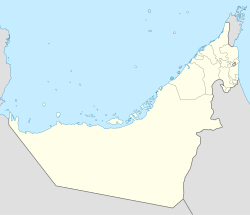The Marar is a tribe of the United Arab Emirates (UAE), a subsection of the Bani Yas.
The Bani Kaab is an Arab tribe in Oman and the United Arab Emirates, also evident in other Gulf countries.
The Tunaij, also spelled as Tanaij, is an Arab tribe in the United Arab Emirates (UAE). The Tunaij have mostly settled in Dhaid, the inland oasis town of Sharjah, and the Ras Al Khaimah town of Rams. A small number of Tunaij also settled at Hamriyah.
The Shihuh is an Arab tribe living in the United Arab Emirates (UAE) and Oman. In the singular, the name is Al Shehhi, a common family name in the UAE and Oman today. Inhabiting the northern part of the Hajar Mountain range, specifically in the Ruus Al Jibal, the tribe has long been influential in the affairs of both the east and west coast settlements of the northern UAE and Oman and has fiercely maintained both its identity and independence.
Bani Shatair is a tribal name, originating in Ras Al Khaimah, in the United Arab Emirates (UAE) and in areas of Northern Oman.
The Al Bu Shamis or Al Shawamis is an Arab Bedouin tribe that mostly inhabit the southeastern part of the Arabian Peninsula. They are located mainly in the United Arab Emirates and Northern Oman.
The Naqbiyin is a tribe of the United Arab Emirates (UAE). They are mostly settled within the emirates of Sharjah and Ras Al Khaimah and have long been influential in the tribal politics of both emirates.
Maktoum bin Butti was the joint founder and first ruler of Dubai, today one of the United Arab Emirates, alongside Obeid bin Said bin Rashid, with whom he led a migration of the Al Bu Falasah from Abu Dhabi, seceding from the Bani Yas.
Sheikh Sultan bin Salim Al Qasimi was Ruler of Ras Al Khaimah from 1921–1948. His long and turbulent rule was characterised by internecine family and tribal disputes and he was finally removed as Ruler in a 1948 coup.
Sheikh Rashid bin Ahmad Al Mualla was the Ruler of Umm Al Quwain from 1904–1922, one of the Trucial States and today one of the seven emirates forming the United Arab Emirates (UAE). He gained influence over the tribes of the interior at the expense of the pre-eminent Trucial Ruler of the time, Sheikh Zayed bin Khalifa Al Nahyan.
The Bani Qitab is a tribe of the United Arab Emirates (UAE) and Sultanate of Oman. The singular form of the name, Al Ketbi, is a common family name in the Northern UAE today. Consisting of a settled southern section and a nomadic northern section, the tribe was long influential in the conduct of affairs in the interior of the Trucial States. The Northern branch mostly settled in the inland towns of Dhaid and Al Falayah.
The Na'im is an Arab tribe in the United Arab Emirates. The tribe is also present in other gulf countries.
The Kunud is a tribe of the United Arab Emirates (UAE) and Oman.
The AlManasir is a tribe of the United Arab Emirates (UAE). Nomadic, warlike and fiercely independent, they roamed between Buraimi and Qatar, the Persian Gulf coast to Liwa and also settled in the Northern emirates. They subsisted through date farming, pearling and moving goods with their camel trains, as well as camel breeding.
The Mazari is a tribe of the United Arab Emirates (UAE). The Mazari settled throughout the Trucial States but principally in Abu Dhabi. They are considered a subsection of the Bani Yas and formed the majority of the Bedouin component of that federation of tribes.
The Sharqiyin is a tribe of the United Arab Emirates (UAE).
The Dhawahir is a tribe of the United Arab Emirates (UAE). The tribe's main centre was the Buraimi Oasis and the village, then town of Al Ain. They have long had a strong alliance with the Ruling family of Abu Dhabi, the Al Nahyan, and the Bani Yas confederation.
The Awamir is a Bedouin Arab tribe in the United Arab Emirates (UAE) and Oman. Warlike and fiercely independent, they were camel breeders, raiders and occasionally date farmers before settling in the 1960s.

The Khawatir is an Arab tribe of the United Arab Emirates, a subsection of the Na'im.

The Al Bu Kharaiban is an Arab tribe of the United Arab Emirates, a subsection of the Na'im and the tribe from which the Rulers of the Emirate of Ajman are drawn.



